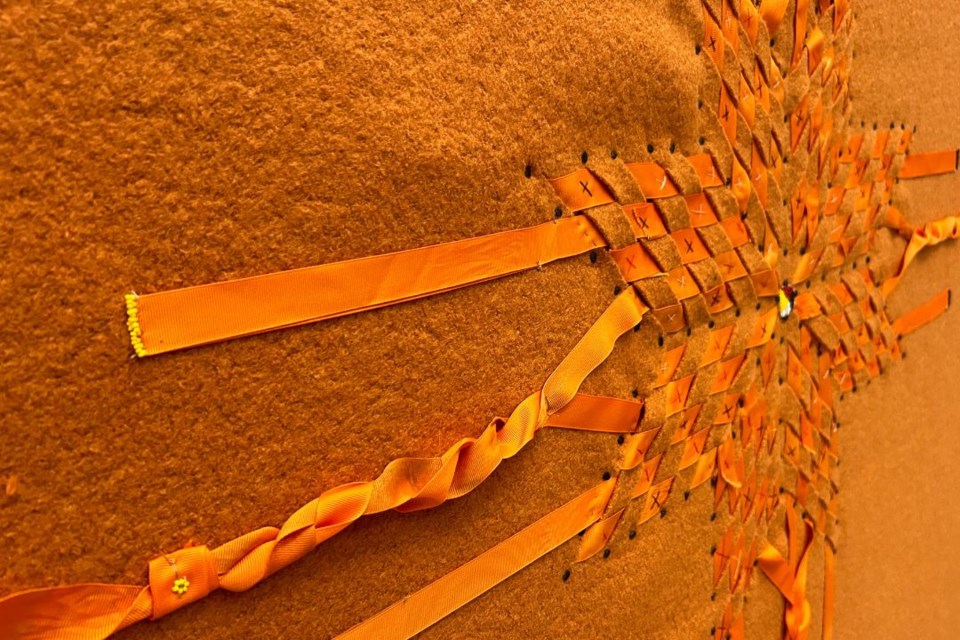SASKATOON — When Le Estcwicwéý (the missing)* were located at Tk’emlúps Residential School in Kamloops, B.C., Donna van de Velde was moved to action.
“I knew I had to do something, originally I wanted to tie broadcloth,” said van de Velde, who championed this work in her previous role at the Murray Library and now works in the kihci-okâwîmâw askiy Knowledge Centre located in the College of Agriculture at the University of Saskatchewan (USask).
“I was quickly connected with jake moore (University Art Gallery director) and others at USask who had similar ideas, and we decided to start tying orange ribbons, one for each spirit, to buildings across campus.”
“We wanted everyone who joined us in hanging one of these ribbons to make a pledge, promising to learn more about residential schools,” she said, adding that as more unmarked graves were found, the need for commemoration grew, resulting in over 9,000 ribbons being placed across campus.
Those ribbons eventually became The Blanket Project.
After a year had passed, van de Velde and others involved in the project planned to burn the ribbons in a sacred fire, but soon realized the nylon ribbons would be toxic, so they looked for another way to honour these ribbons.
“We took it to the Mistatimōk Committee and the idea to weave them into blankets was brought up,” said van de Velde. “There is so much significance in being gifted a blanket. It’s just such an honour.”
Blankets, a symbol of honour and healing, are a beautiful part of the project. But not wanting to shy away from the harsh reality of being a child in residential school, the group chose a specific type of fabric.
“Children were given blankets made from itchy material, so we used that in our blankets,” said van de Velde. “We wanted to take something that gave no comfort and make something positive out of it by weaving the ribbons through it.”
More than 150 USask staff, faculty and students have taken part in this project, coming together and taking the time to learn from Elders and Knowledge Keepers while working to master the art of weaving star blankets.
“This was an important experience where I was able to hear from Elders, but also be hands-on,” said Carrie Vassilakopoulos, executive assistant to the Dean of Agriculture and Bioresources.
“I learned quickly that everything had meaning: the threads were the colours of the medicine wheel and the stitches were X’s because that’s how some of the chiefs signed treaties.”
The blanket Vassilakopoulos worked on is now on display in the College of Agriculture and Bioresources.
“Now that I can see the blanket on display, I see it as another opportunity to reflect on all the work that still needs to be done,” said Vassilakopoulos.
This long sustained project evolved and grew over time to meet the needs of the community. USask community members came together to complete the blanket project in August, 2024.
“I’m very proud of how the Mistatimōk committee has come together to support this four-year project, and for all the ways they found for people to participate,” said Dr. Angela Jaime (PhD), vice-provost, Indigenous Engagement.
In addition to the success of the committee, the commitment from staff, faculty and students who have participated is significant.
“Ultimately, when I walk past those blankets, I know I can hold people accountable to the commitments that they have made,” said Jaime. “Their willingness to listen and learn is in something they have created, and it’s tangible.”
During 2024’s Week of Reflection, blankets woven and sewed by groups across campus were framed and displayed in prominent locations around campus. There are QR codes next to each blanket that will provide information about the project. Each of the blankets have tobacco incorporated in or on top of the frames as an offering of gratitude. The USask units who have participated in the project and honour the missing are on display in:
Agriculture Building
Murray Library
Gwenna Moss Centre
USSU – Place Riel Student Centre
Education
UGSO – Arts Tower (second floor)
Husky Athletics – PAC Track
Kinesiology
Edwards School of Business
*Locating the missing is never referred to as a number. Residential school survivors have said that as students they were always referred to as a number, never names. In response to this, Elders from Tk’emlúps te Secwépemc have named them Le Estcwicwéy̓ (which means “the missing”).
— Submitted by USask Media Relations




